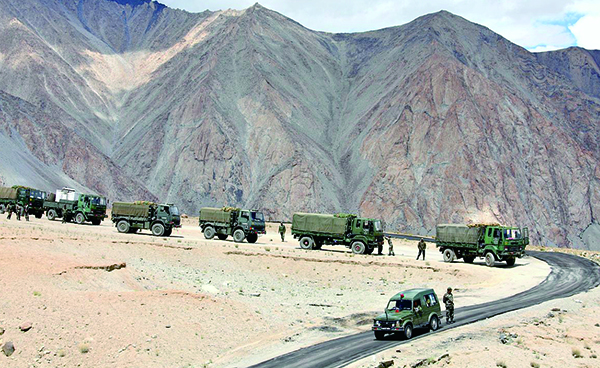Deal Firmly With Chinese Misadventure
What are the roots of rage in China? Why is it trying to act so aggressive all around its frontiers even while the Covid pandemic is raging around the world? We can look for plausible solutions only when we understand why China is behaving the way it is.
Chinese behavior stems from a deep rooted sense of insecurity. China feels itself under pressure on all fronts. Hong Kong and Xinjiang are on fire. Tibet is restive. The USA is arming Taiwan heavily and encouraging it to take a stand. The Tibetan diaspora is restive and the tiny nations of South East Asia have, at long last, found their voice. Japan is arming its forces rapidly. It is adding new F-35 fighters and has converted two helicopter carriers into aircraft carriers.
The USA has waged a relentless trade war with China and currently has four aircraft carrier battle groups (CBGs) deployed in the Pacific. Two of them are in the South China Sea even as China is carrying out a major amphibious landing military exercise there.
The Biological Pearl Harbour
This deep sense of insecurity, some experts conjecture had, perhaps, caused China to lash out with a pre-emptive biological warfare strike designed to weaken and destabilise its adversaries. In the wake of this pandemic, China’s overtly aggressive behaviour seems to suggest that the Chinese armed forces had a degree of fore knowledge of the pandemic. In hindsight, China’s aggressive behaviour against Taiwan, in the South China Sea and East China Sea, almost looks like an attempt at military exploitation in the wake of biological warfare first strike. There are unsubstantiated but credible speculations that China genetically engineered this bat coronavirus in the Wuhan Lab. It was either accidentally or even deliberately leaked from the lab. Patient Zero, it is now said, was Dr Yangling of the same Wuhan lab. Experts speculate that is why China was able to recover much faster from this epidemic simply because it was ready, forewarned and forearmed about its likely outbreak.
China tried to exploit the pandemic economically first and then militarily. The pandemic broke out officially in December 2019 (unofficially, the time line is now being pushed back to November or even October 2019). From January 2020 onwards, China began a series of major air and naval exercises off Taiwan and in the South China Sea. The Americans sent forward the CBGs USS Ronald Reagan and USS Theodore Roosevelt. Both were disabled due to the coronavirus infecting their crews. China then triumphantly flaunted both its aircraft carriers – Liaoning and Shandong in the East China Sea, against Taiwan and then in the South China Sea. It is now carrying out a major amphibious landing exercise in the strategic Bashi Channel, southeast of Taiwan. The Taiwanese hold an island in that area. China could well try and suddenly seize that island under the cover of these exercises. To stymie that, the USA has moved two nuclear powered aircraft carriers – the USS Nimitz and USS Ronald Reagan – into the South China Sea in a very aggressive show of support to its allies.
Chinese Moves in Eastern Ladakh
Chinese strategic culture insists upon just one strategic direction at any given point of time. Currently, in view of the vital significance of China’s East Coast wealth creation and industrial centres – it is towards Taiwan and the South & East China seas – that is all facing the Pacific flank. That is why the world was intensely surprised when the Chinese military made a very calculated move to ignite Eastern Ladakh.
For decades now China has been talking about the War Zone Concept – the plan to focus all of China’s military resources against one military target at a time and do that sequentially with Taiwan, Vietnam, India, Japan and even Russia starting with the year 2020. Retired Chinese Generals have even published these timelines as to how each of these countries would be targeted one after another from 2020 onwards.
Nevertheless, when China’s Eastern Sea board was aflame with tensions and massive military deployments, it went against all of the China’s stated military doctrines to open another front concurrently in the Western Theatre with India. China surprised India and the world by doing just that. It’s 4th Highland Motorised Infantry Division and 6th Mechanized Division (that are based in Xinjiang) were exercising opposite Eastern Ladakh around 19 April this year. In the first week of May, two brigades of the 6th Mechanized Division made a lunge for the Galwan Valley and Pongong Tso Lake areas. Some elements went opposite the Hot Springs, even as the 4th Highland Motorised Infantry Division postured against Depsang and Daulat Beg Oldie (DBO). The sudden move forward of these two offensive formations posed a significant threat to the newly constructed 255 km Darbukh-Shyok-DBO road that has just been completed at such great cost and effort.
So, it is not so much yards and inches of Indian territory being nibbled here and there or being salami-sliced. Much more important is the move forward of two Chinese Mechanized Divisions that pose a significant threat in being to our Darbukh-Shyok-DBO road. This vital road runs parallel to the Line of Actual Control (LAC) and is vulnerable to being cut off almost along its entire length.
India counter mobilized and rapidly matched (and then even exceeded) Chinese force levels in this area. The Chinese were taken aback and somewhat surprised by the speed and scale of the Indian response. They decided to cool things down a bit. Talks started between local brigade commanders, divisional commanders and finally at the Corps Commander’s level on 6 June 2020. Both sides decided to disengage by pulling back troops some 1.50 to 2 kms either side of the face off locations.
15 June 2020 Incident
To everyone’s surprise and horror, not only did the Chinese not move back but on 15-16 June night, they engineered a very ugly clash. Though no kinetic military force was used and they did not technically use firearms (as per article VI of the 1996 Agreement), they did use lethal force (iron rods , knives, stones, etc) that resulted in 20 Indian casualties. This marks a paradigm shift on the India-China border, where peace has held for the last 53 years (since the Nathu La clash of 1967). Some 250 Indian and 400 Chinese troops were involved in fierce hand-to-hand combat then. This time Chinese casualties, though not disclosed, were 43 as per Indian and 35 as per CIA estimates. Strangely, the clash happened on Xi Jinping’s birthday and speculations are China’s Western Theatre Commander Gen Zhao Zhonqi wanted to please his boss. It went a bit awry because the results of the hand-to-hand clash left the Chinese quite stunned.
Negotiations were reopened at the Corps Commander level. Finally, on 6 July 2020, the Indian national security adviser (NSA) talked to the Chinese foreign minister and disengagement was agreed to. Resultantly, the Chinese have reportedly gone back by 1.5 kms in Galwan and so have we. Some elements are touting it as a great victory – a push back of China. This celebration is childish and uncalled for and may well be very premature. If the Chinese are so easily persuaded to go back from their positions, it calls into question why they came up there in the first place? I do not buy the theory that they were merely testing our reactions.
The Way Ahead
So what is the way ahead?
We have constructed a road to DBO at considerable cost and effort. Roads are not protected by patrolling but by physically holding key terrain features that overlook the road. India’s first priority should be to jettison the failed accords of 1993, 1996, etc, and now secure the key terrain by physically holding and constructing strong defenses on the high ground east and west of the road.
Kinetic Action. We are still trying to resolve the issue peacefully and by negotiations. If it works, well and good. If not, let us understand some basic facts:-
• India is well poised militarily on the Himalayan front. We have a distinct edge in air power, mountain warfare trained formations deployed forward and recent combat experience.
• Internationally the whole world is sick and tired of China’s export of Covid-19, which has infected 12 million people and killed some 6 lakhs. 130 countries voted for an enquiry on Covid-19 against China. The South East Asian nations would be very happy if India responded strongly.
• China may not want an escalation to kinetic level right now. We did not start this fracas. Why then are we obliged to go along? Why should the rest of world play by the rules set by China? India will have to break China’s stranglehold upon the initiative. We may have to call China’s bluff. Bullying India must not be allowed to pass off as an annual exercise that is repeated year after year.
The real problem is not so much the inches of land here and there that we must defend against Chinese salami-slicing. That is the border guarding task. However, it is the hostile massing of two mechanized divisions upon our borders in Eastern Ladakh that poses a major threat beyond border guarding. These formations must go back to Xinjiang from where they came. Status quo ante must be restored. If issues are resolved peacefully, so much the better. If not, India does have a whole range of highly credible military options well short of full scale war. This is not the India of 1962 and the time may well be opportune for India to react strongly to uncalled for bullying. The international environment could not be more favourable for a strong push back by India.
China needs to return to status quo ante. If that is not done, India will have to be prepared to raise the ante so that the threat to our communications is removed and a meaningful dialogue takes place for finally resolving the vexed border dispute. India has rightly adopted a whole-of-the-government approach and used all elements of national power – military, diplomatic and economic – to push back China. Ultimately however, India will have to give a military response to a straight forward military challenge.

















